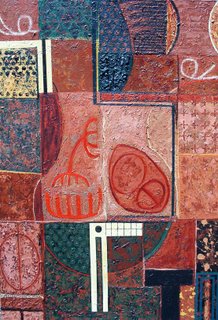
When integrated into a practice of “real space” art activity, digital art forms can be powerfully expressive for a traditional artist. My interest in digital art focuses on the networked computer’s potential to create community. For me, the computer’s use as a fine art image-making tool takes a back seat to its potential to unite people in intercultural understanding. My research consists of the execution of collaborative projects involving artists and a diversity of other humans around the world. These projects extend our “real space” traditional studio practices into those for which location, nationality, and narrative continually shift their focus between the virtual, the interpersonal and the tactile.
Trained as a painter and printmaker, from 1978 to 1994 I pursued a single-minded path of production, exhibition, and sales of my studio work. My paintings and prints reflect my interest in language shapes and random cross-pollination of gestures, pressings, stampings, and scrapings. Most of my painting work is highly tactile. For me, the tactility emphasizes the human touch, the immediacy of being hand made.
The appreciation of this aura-object quality requires real-space presence. When I began to finally learn to use the computer to make images, this split between on-screen and real-space was pronounced for me. I made a few attempts at solving a painting’s compositional problems with the computer but in the end my impulse was always to make the decision in front of the canvas.
Digital imagery fascinated me though for another reason - its existence, the ability to make any image, anywhere, anytime, and distribute it in an infinite number of ways an infinite number of times, across cultures, without the imperative of language or serious financial outlay – this obviously changed the place/role of imagery and art in a profound way. The freedom to connect through imagery with other groups of artists, to work in collaboration via email and the web – this possibility was fascinating.
An early piece: Artwire
- 3 schools,
Cleveland State University,
Kunstseminar Freie Hochschule (now Fachhochschule Schwaebisch Hall),
the University of Maryland/ College Park - 15 students sent each other art assignments - resulting video, audio, print and documentary pieces posted online (unfortunately, 10 years later the sites no longer exist)
- Three resulting exhibitions in real space
- Led to the student trip to Germany and German students coming to US
Being/Sein - American students spend a month in Germany in the class "Sense of Place/ Place of Technology"
- Can an experience in real space be expressed online?
- Journaling/ QTVR
Do you remember your grandparents? - In connection with big painting show at the
Plains Art Museum in Fargo, North Dakota
- My grandparents lived in Fargo area
- Want to honor their memory and my return
- Want to use the web to connect my relatives, North Dakotans, and the world
- Stories uploaded automatically, had to email me the photos
- Stories posted by native american children
- No longer taking stories
TransCultural Exchange - I am the Assistant Director
- Met Director Mary Sherman (Boston) during junior year abroad, Vienna
- Mission to unite artists online, create dialogue, promote peace through transcultural understanding, have real space exhibitions and meet in real space to extend the dialogue in future exhibitions.
- Have had exhibitions on every continent including Antarctica
Coaster Project - Exhibitions, then distribution for free on all continents
- Performance aspect
- Extensive
press coverage - Award for best show in alternative space from International Association of Art Critics
- Four page spread in International Gallerie Magazine
Tile Project - 100+ artists
- 22 permanent public installations: Fine Arts Museum of Ho Chi Minh City; Arts Academy of Azerbaijan; Mercer Park, NY, etc
- artists travel to each other’s opening receptions, create networking
- Sponsors include UNESCO, Soros Foundation, Boston College, Asian Cultural Council, MIT, Puffin Foundation, Hewlett Packard…
- University collaborations parallel main artists’ project
- Grade school and high school peace projects
- Wiki site allows contributions from all parties
- I will be in Manila and possibly Bosnia in the summer
- Was in Azerbaijan in February
My trip to Azerbaijan - Hosted by artist Chingiz Babayev
- Installation at the Arts Academy sponsored by Soros Foundation
- Post Soviet government, oil drilling
- Muslim country
- Qobustan
- some of the oldest petroglyphs in the world.















